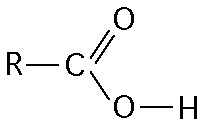
What is the name of the functional group shown in the figure above?
A) carbonyl
B) ketone
C) aldehyde
D) carboxyl
E) hydroxyl
D
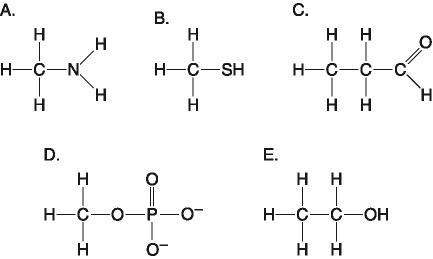
Which molecule shown above is a thiol?
A) A
B) B
C)
C
D) D
E) E
B
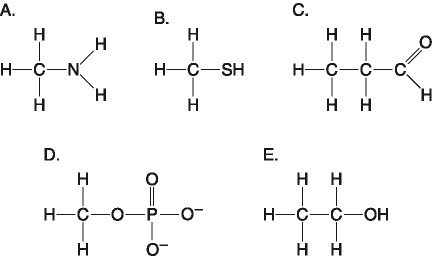
Which molecule shown above contains an amino functional group, but is
not an amino acid?
A) A
B) B
C) C
D) D
E) E
A
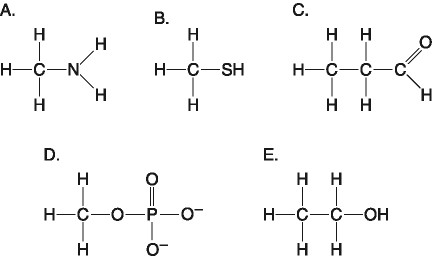
Which molecule shown above contains a functional group that cells use
to transfer energy between organic molecules?
A) A
B) B
C) C
D) D
E) E
D

Which of the following statements is true regarding the molecule
illustrated in Figure 5.2?
A) It is a saturated fatty acid.
B) It is a saturated fatty acid and a diet rich in this molecule may contribute to atherosclerosis.
C) A diet rich in this molecule may contribute to atherosclerosis.
D) Molecules of this type are usually liquid at room
temperature.
E) It is a saturated fatty acid, a diet
rich in this molecule may contribute to atherosclerosis, and
molecules of this type are usually liquid at room temperature.
B

Which of the following statements is true regarding the molecule
illustrated in Figure 5.3?
A) It is a saturated fatty acid.
B) Molecules of this type are usually liquid at room temperature.
C) A diet rich in this molecule may contribute to atherosclerosis.
D) It is a saturated fatty acid and a diet rich in this
molecule may contribute to atherosclerosis.
E) It is a saturated
fatty acid, a diet rich in this molecule may contribute to
atherosclerosis, and molecules of this type are usually liquid at room temperature.
B

The molecule shown in Figure 5.3 is a
A) polysaccharide.
B) polypeptide.
C) saturated fatty acid.
D)
triacylglycerol.
E) unsaturated fatty acid.
E
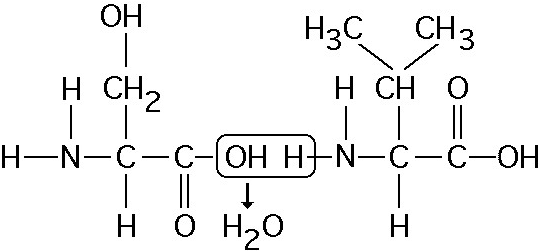
Which of the following statements is/are true regarding the chemical reaction illustrated in Figure 5.5?
A) It results in a peptide bond.
B) It is a hydrolysis
reaction.
C) It joins two fatty acids together.
D) It is a
hydrolysis reaction and it results in a peptide bond.
E) It is a
hydrolysis reaction, it results in a peptide bond, and it joins two
fatty acids together.
A
A new organism is discovered in the forests of Costa Rica. Scientists there determine that the polypeptide sequence of hemoglobin from the new organism has 72 amino acid differences from humans, 65 differences from a gibbon, 49 differences from a rat, and 5 differences from a frog. These data suggest that the new organism
A) is more closely related to frogs than to humans.
B) is more
closely related to humans than to frogs.
C) evolved at about the
same time as frogs, which is much earlier than primates and mammals.
D) is more closely related to humans than to rats.
E) is
more closely related to frogs than to humans and also evolved at about
the same time as frogs, which is much earlier than primates and mammals.
A
Research indicates that ibuprofen, a drug used to relieve
inflammation and pain, is a mixture of two enantiomers; that is,
molecules that
A) have identical chemical formulas but differ in
the branching of their carbon skeletons.
B) exist in either
linear chain or ring forms.
C) differ in the location of their
double bonds.
D) are mirror images of one another.
E) differ in the arrangement of atoms around their double bonds.
D
A compound contains hydroxyl groups as its predominant functional group. Which of the following statements is true concerning this compound?
A) It should dissolve in water.
B) It lacks an asymmetric
carbon, and it is probably a fat or lipid.
C) It should dissolve
in a nonpolar solvent.
D) It won't form hydrogen bonds with
water.
E) It is hydrophobic.
A
Which two functional groups are always found in amino acids?
A)
ketone and methyl
B) carboxyl and amino
C) carbonyl and amino
D) amino
and sulfhydryl
E) hydroxyl and carboxyl
B
Which of the following is not a monomer/polymer pairing?
A) monosaccharide/polysaccharide
B) amino acid/protein
C) deoxyribonucleotide/DNA
D) ribonucleotide/RNA
E) triglyceride/phospholipid bilayer
E
What is the chemical reaction mechanism by which cells make polymers
from monomers?
A) phosphodiester linkages
B) hydrolysis
C) ionic bonding of monomers
D) the formation of disulfide bridges between monomers
E) dehydration reactions
E
Which of the following best summarizes the relationship between
dehydration reactions and hydrolysis?
A) Dehydration reactions
assemble polymers, and hydrolysis reactions break down polymers.
B) Dehydration reactions eliminate water from lipid membranes,
and hydrolysis makes lipid membranes water permeable.
C)
Dehydration reactions can occur only after hydrolysis.
D)
Hydrolysis creates monomers, and dehydration reactions break down
polymers.
E) Dehydration reactions ionize water molecules and
add hydroxyl groups to polymers; hydrolysis reactions release hydroxyl
groups from polymers.
A
The molecular formula for glucose is C₆H₁2O₆. What would be the molecular formula for a molecule made by linking three glucose molecules together by dehydration reactions?
A) C₁₈H₃₂O₁₆
B) C₁₈H₃₆O₁₈
C) C₆H₁₀O₅
D) C1₈H₁₀O₁₅
E) C₃H₆O₃
A
Why are hydrocarbons insoluble in water?
A) The majority of
their bonds are polar covalent carbon-to-hydrogen linkages.
B) They are hydrophilic.
C) They exhibit considerable molecular complexity and diversity.
D) The majority of their bonds are nonpolar covalent carbon-to-hydrogen linkages.
E) They are lighter than water.
D
There are 20 different amino acids. What makes one amino acid
different from another?
A) different side chains (R groups)
attached to a carboxyl carbon
B) different side chains (R groups) attached to the amino groups
C) different structural and optical isomers
D) different asymmetric carbons
E) different side chains (R groups) attached to an α carbon
E
The tertiary structure of a protein is the
A) bonding together
of several polypeptide chains by weak bonds.
B) unique three-dimensional shape of the fully folded polypeptide.
C) order in which amino acids are joined in a polypeptide chain.
D) organization of a polypeptide chain into an α helix or β pleated sheet.
E) overall protein structure resulting from the aggregation of two or more polypeptide subunits.
B
Changing a single amino acid in a protein consisting of 325 amino acids would
A) always alter the primary structure of the protein, sometimes alter the tertiary structure of the protein, and affect its biological activity.
B) alter the primary structure of the protein, but not its tertiary structure or function.
C) cause the tertiary structure of the protein to unfold.
D) always alter the biological activity or function of the protein.
E) always alter the primary structure of the protein and disrupt its biological activity.
A
The nuclear lamina is an array of filaments on the inner side of the
nuclear membrane. If a method were found that could cause the lamina
to fall into disarray, what would you expect to be the most likely
consequence?
A) the loss of all nuclear function
B) the
inability of the nucleus to divide during cell division
C) a
change in the shape of the nucleus
D) failure of chromosomes to
carry genetic information
E) inability of the nucleus to keep out
destructive chemicals
C
A cell with a predominance of free ribosomes is most likely
A)
producing primarily proteins for secretion.
B) constructing an extensive cell wall or extracellular matrix.
C) producing primarily cytoplasmic proteins.
D) digesting large food particles.
E) enlarging its vacuole.
C
Tay-Sachs disease is a human genetic abnormality that results in
cells accumulating and becoming clogged with very large, complex,
undigested lipids. Which cellular organelle must be involved in this
condition?
A)the endoplasmic reticulum
B)the Golgi apparatus
C) mitochondrion
D)the lysosome
E)membrane-bound ribosomes
D
Which of the following produces and modifies polysaccharides that
will be secreted?
A) vacuole
B)Golgi apparatus
C)mitochondrion
D)lysosome
E)peroxisome
B
One of the key innovations in the evolution of eukaryotes from a
prokaryotic ancestor is the endomembrane system. What eukaryotic
organelles or features might have evolved as a part of, or as an
elaboration of, the endomembrane system?
A) chloroplasts
B) nuclear envelope
C) mitochondria
D) plasma
membrane
E) none of these
B
A cell has the following molecules and structures: enzymes, DNA,
ribosomes, plasma membrane, and mitochondria. It could be a cell
from
A) a bacterium.
B) an animal, but not a plant.
C) any multicellular organism, like a plant or an animal.
D) nearly any eukaryotic organism.
E) any kind of organism.
C
Which type of interaction stabilizes the α helix and the β pleated
sheet structures of proteins?
A) hydrophobic interactions
B) disulfide bonds
C) ionic bonds
D) hydrogen bonds
E) peptide bonds
D
Which level of protein structure do the α helix and the β pleated sheet represent?
A) secondary
B) primary
C) tertiary
D) quaternary
E) primary, secondary, tertiary, and quaternary
A
Why isn't the mitochondrion classified as part of the endomembrane system?
A) Its structure is not derived from the ER or Golgi.
B) It is a static structure.
C) It has too many vesicles.
D) It is not involved in protein synthesis.
E) It is not attached to the outer nuclear envelope.
A
What types of proteins are not synthesized in the rough ER?
A)
endoplasmic reticulum proteins
B) extracellular matrix proteins
C) mitochondrial proteins
D) secreted proteins
E) plasma membrane proteins
C
Which animal cell organelle contains enzymes that transfer hydrogen from various substrates to oxygen?
A) peroxisome
B) lysosome
C) vacuole
D) mitochondrion
E) Golgi apparatus
A
The evolution of eukaryotic cells most likely involved
A) anaerobic archaea taking up residence inside a larger
bacterial host cell to escape toxic oxygen-the anaerobic bacterium
evolved into chloroplasts.
B) endosymbiosis of an aerobic bacterium in a larger host cell-the endosymbiont evolved into mitochondria.
C) an endosymbiotic fungal cell evolved into the nucleus.
D) acquisition of an endomembrane system, and subsequent
evolution of mitochondria from a portion of the Golgi.
B
In a liver cell detoxifying alcohol and some other poisons, the
enzymes of the peroxisome remove hydrogen from these molecules
and
A) combine the hydrogen with water molecules to generate
hydrogen peroxide.
B) use the hydrogen to break down hydrogen
peroxide.
C) transfer the hydrogen to the mitochondria.
D)
transfer the hydrogen to oxygen molecules to generate hydrogen peroxide
D
Movement of vesicles within the cell depends on what cellular
structures?
A) microtubules and motor proteins
B) actin
filaments and microtubules
C) actin filaments and
ribosomes
D) centrioles and motor proteins
E) actin
filaments and motor proteins
A
Which of the following contain the 9 + 2 arrangement of microtubules,
consisting of nine doublets of microtubules surrounding a pair of
single microtubules?
A) both motile cilia and primary (nonmotile)
cilia
B) centrioles only
C) both flagella and motile
cilia
D) both basal bodies and primary (nonmotile) cilia
E)
both centrioles and basal bodies
C
Vinblastine, a drug that inhibits microtubule polymerization, is used
to treat some forms of cancer. Cancer cells given vinblastine would be
unable to
A) form cleavage furrows during cell division.
B)
migrate by amoeboid movement.
C) separate chromosomes during cell
division.
D) extend pseudopods.
E) maintain the shape of the nucleus.
C
When a potassium ion (K+) moves from the soil into the vacuole of a
cell on the surface of a root, it must pass through several cellular
structures. Which of the following correctly describes the order in
which these structures will be encountered by the ion?
A) plasma
membrane → primary cell wall → cytoplasm → vacuole
B) secondary
cell wall → plasma membrane → primary cell wall → cytoplasm →
vacuole
C) primary cell wall → plasma membrane → cytoplasm →
vacuole
D) primary cell wall → plasma membrane → lysosome →
cytoplasm → vacuole
E) primary cell wall → plasma membrane →
cytoplasm → secondary cell wall → vacuole
C
The extracellular matrix is thought to participate in the regulation
of animal cell behavior by communicating information from the outside
to the inside of the cell via which of the following?
A) gap
junctions
B) the nucleus
C) DNA and RNA
D)
integrins
E) plasmodesmata
D
Ions can travel directly from the cytoplasm of one animal cell to the
cytoplasm of an adjacent cell through
A) plasmodesmata.
B)
intermediate filaments.
C) tight junctions.
D)
desmosomes.
E) gap junctions.
E
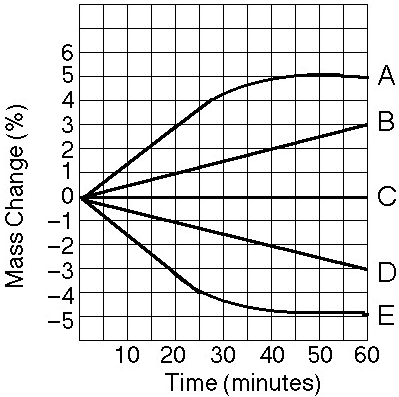
Five dialysis bags, constructed from a semipermeable membrane that is impermeable to sucrose, were filled with various concentrations of sucrose and then placed in separate beakers containing an initial concentration of 0.6 M sucrose solution. At 10-minute intervals, the bags were massed (weighed) and the percent change in mass of each bag was graphed.
Which line in the graph represents the bag that contained a
solution isotonic to the 0.6 M solution at the beginning of the
experiment?
A) A
B) B
C) C
D) D
E) E
C
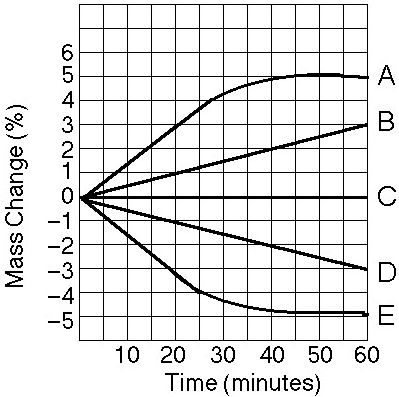
Which line in the graph represents the bag with the highest initial
concentration of sucrose?
A) A
B) B
C) C
D) D
E) E
A
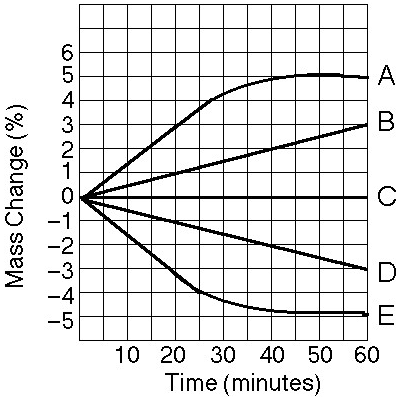
Which line or lines in the graph represent(s) bags that contain a
solution that is hypertonic at 50 minutes?
A) A and B
B) B
C) C
D) D
E) D and E
B
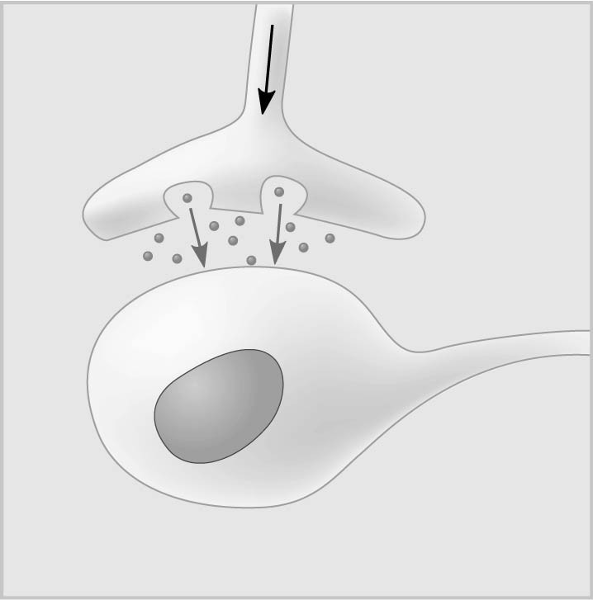
Which of the following types of signaling is represented in the
figure?
A) autocrine
B) paracrine
C) hormonal
D) synaptic
E) long distance
D
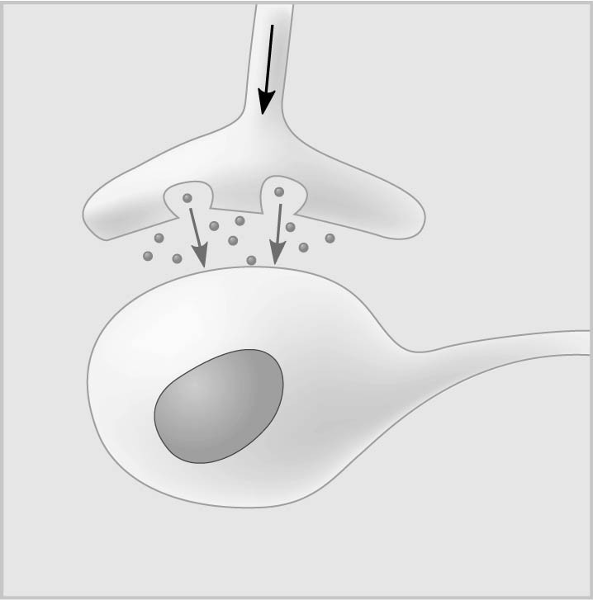
In the figure, the dots in the space between the two structures
represent which of the following?
A) receptor molecules
B)
signal transducers
C) neurotransmitters
D) hormones
E) pheromones
C
Cystic fibrosis is a genetic disease in humans in which the CFTR
protein, which functions as a chloride ion channel, is missing or
nonfunctional in cell membranes.
71) The CFTR protein
belongs to what category of membrane proteins?
A) gap
junctions
B) aquaporins
C) electrogenic ion pumps
D)
cotransporters
E) hydrophilic channels
C
You are working on a team that is designing a new drug. In order for
this drug to work, it must enter the cytoplasm of specific target
cells. Which of the following would be a factor that determines
whether the molecule selectively enters the target cells?
A)
blood or tissue type of the patient
B) hydrophobicity of the drug
molecule
C) lack of charge on the drug molecule
D)
similarity of the drug molecule to other molecules transported by the
target cells
E) lipid composition of the target cells' plasma membrane
D
Some regions of the plasma membrane, called lipid rafts, have a
higher concentration of cholesterol molecules. At high temperatures,
these regions
A.are more fluid than the surrounding
membrane.
B.detach from the plasma membrane and clog
arteries.
C.have higher rates of lateral diffusion of lipids and
proteins into and out of these regions.
D.are able to flip from
inside to outside.
E.are less fluid than the surrounding membrane.
E
Which of the following is one of the ways that the membranes of
winter wheat are able to remain fluid when it is extremely cold?
A. by cotransport of glucose and hydrogen
B. by using
active transport
C. by increasing the percentage of cholesterol
molecules in the membrane
D. by increasing the percentage of
unsaturated phospholipids in the membrane
E. by decreasing the
number of hydrophobic proteins in the membrane
D
In order for a protein to be an integral membrane protein it would
have to be
A. exposed on only one surface of the
membrane.
B. amphipathic, with at least one hydrophobic
region.
C. completely covered with phospholipids.
D.
hydrophobic.
E. hydrophilic.
B
The primary function of polysaccharides attached to the glycoproteins
and glycolipids of animal cell membranes is
A. to
maintain the integrity of a fluid mosaic membrane.
B. to mediate
cell-to-cell recognition.
C. to maintain membrane fluidity at
low temperatures.
D. to facilitate diffusion of molecules down
their concentration gradients.
E. to actively transport
molecules against their concentration gradients.
B
Why are lipids and proteins free to move laterally in
membranes?
A. Molecules such as cellulose can pull them
in various directions.
B. The interior of the membrane is filled
with liquid water.
C. Hydrophilic portions of the lipids are in
the interior of the membrane.
D. There are only weak hydrophobic
interactions in the interior of the membrane.
E. Lipids and
proteins repulse each other in the membrane.
D
Over the years, the fluid mosaic model has been refined based on
recent experimental findings. In the years since the proposal of the
fluid mosaic model of the cell membrane, which of the following
observations has been added to the model?
A. Membrane
proteins are made of only acidic amino acids.
B. The membrane is
only fluid across a very narrow temperature range.
C. Proteins
rarely move in the membrane.
D. The concentration of protein
molecules appears to be much higher.
E. Unsaturated lipids are
excluded from the membranes and do not contribute to membrane fluidity.
D
Cell membranes are asymmetrical. Which of the following statements is
the most likely explanation for the membrane's asymmetrical
nature?
A. Because the cell membrane forms a border
between one cell and another in tightly packed tissues such as
epithelium, the membrane must be asymmetrical
B. Because cell
membranes communicate signals from one organism to another, the cell
membranes must be asymmetrical.
C. The chemical constitution of
the inner and outer layer of the cell membrane is predetermined by
genes.
D. The two sides of a cell membrane face different
environments and carry out different functions.
E. Proteins only
function on the cytoplasmic side of the cell membrane, which results
in the membranes asymmetrical nature.
D
Which of the following is true for the evolution of cell
membranes?
A. An individual organism selects its
preferred type of cell membrane for particular functions.
B. The
evolution of cell membranes is driven by the evolution of
glycoproteins and glycolipids.
C. The fluid mosaic nature of
cell membranes provides the explanation for the evolution of cell
membranes.
D. Membrane proteins are the sole component
responsible for the evolution of cell membranes.
E. All
components of membranes evolve as a result of natural selection.
E
The movement of the hydrophobic gas nitrous oxide (N2O) (laughing
gas) into a cell is an example of
A. active
transport.
B. diffusion across the lipid bilayer.
C.
cotransport.
D. facilitated diffusion.
E. osmosis.
B
Which of the following is most likely true of a protein that
cotransports glucose and sodium ions into the intestinal cells of an
animal?
A. Sodium ions can move down their
electrochemical gradient through the cotransporter whether or not
glucose is present outside the cell.
B. Glucose entering the
cell down its concentration gradient provides energy for uptake of
sodium ions against the electrochemical gradient.
C. A substance
that blocks sodium ions from binding to the cotransport protein will
also block the transport of glucose.
D. The cotransporter can
also transport potassium ions.
E. Sodium and glucose compete for
the same binding site in the cotransporter.
C
The phosphate transport system in bacteria imports phosphate into the
cell even when the concentration of phosphate outside the cell is much
lower than the cytoplasmic phosphate concentration. Phosphate import
depends on a pH gradient across the membrane-more acidic outside the
cell than inside the cell. Phosphate transport is an example of
A. passive diffusion.
B. osmosis.
C. facilitated
diffusion.
D. active transport.
E. cotransport.
E
What is the voltage across a membrane called?
A.
chemical gradient
B. osmotic potential
C. membrane
potential
D electrochemical gradient
E water potential
C
The sodium-potassium pump is called an electrogenic pump because
it
A. ionizes sodium and potassium atoms.
B.
contributes to the membrane potential.
C. is used to drive the
transport of other molecules against a concentration
gradient.
D. pumps equal quantities of Na+ and K+ across the
membrane.
E. pumps hydrogen ions out of the cell.
B
Ions diffuse across membranes through specific ion channels
A. down the electrical gradients.
B. down their
electrochemical gradients.
C. down their chemical
gradients.
D. down their concentration gradients.
E. down
the osmotic potential gradients.
B
Which of the following would increase the electrochemical gradient
across a membrane?
A. both a proton pump and a potassium
channel
B. a potassium channel
C. a proton pump
D. a
chloride channel
E. a sucrose-proton cotransporter
C
Proton pumps are used in various ways by members of every domain of
organisms: Bacteria, Archaea, and Eukarya. What does this most
probably mean?
A. Proton pumps must have evolved before
any living organisms were present on Earth.
B. Proton gradients
across a membrane were used by cells that were the common ancestor of
all three domains of life.
C. Cells of each domain evolved
proton pumps independently when oceans became more acidic.
D.
The high concentration of protons in the ancient atmosphere must have
necessitated a pump mechanism.
E. Proton pumps are necessary to
all cell membranes.
B
When protein membrane receptors are activated, what usually
happens?
A. The receptors open and close in response to
protein signals.
B. A change occurs on only one membrane
surface: exterior or interior.
C. A change occurs in
intracellular ion concentration.
D. The receptor preferentially
binds with lipid or glycolipid signal molecules.
E. The receptor
changes conformation after binding with signal polypeptides.
E
Which of the following is true of steroid receptors?
A.
The receptor molecules are themselves lipids or glycolipids.
B.
The receptor molecules are free to move in and out of most
organelles.
C. The unbound steroid receptors are quickly
recycled by lysosomes.
D. The receptor may be inside the nuclear
membrane.
E. The concentration of steroid receptors must be
relatively high in most cells.
D
What is most likely to happen to an animal's target cells that lack
receptors for local regulators?
A. They might not be able
to multiply in response to growth factors from nearby cells.
B.
Hormones would not be able to interact with target cells.
C.
They might compensate by receiving nutrients via a factor.
D.
They could divide but never reach full size.
E. They could
develop normally in response to neurotransmitters instead.
A
Which of the following is characterized by a cell releasing a signal
molecule into the environment, followed by a number of cells in the
immediate vicinity responding?
A. autocrine
signaling
B. hormonal signaling
C. synaptic
signaling
D. endocrine signaling
E. paracrine signaling
E
When a neuron responds to a particular neurotransmitter by opening
gated ion channels, the neurotransmitter is serving as which part of
the signal pathway?
A) receptor
B) relay molecule
C)
transducer
D) signal molecule
E) endocrine molecule
D
Which of the following is true of transcription factors?
A)
They regulate the synthesis of DNA in response to a signal.
B)
They transcribe ATP into cAMP.
C) They initiate the epinephrine
response in animal cells.
D) They control gene expression.
E) They regulate the synthesis of lipids in the cytoplasm.
D
In general, a signal transmitted via phosphorylation of a series of
proteins
A) brings a conformational change to each protein.
B) requires binding of a hormone to a cytosol receptor.
C)
cannot occur in yeasts because they lack protein phosphatases.
D) requires phosphorylase activity.
E) allows target cells
to change their shape and therefore their activity.
A
Which of the following most likely would be an immediate result of
growth factor binding to its receptor?
A) protein kinase
activity
B) adenylyl cyclase activity
C) GTPase activity
D) protein phosphatase activity
E) phosphorylase activity
A
The function of phosphatases in signal transduction is best described
as to
A) move the phosphate group of the transduction pathway to
the next molecule of a series.
B) prevent a protein kinase from
being reused when there is another extracellular signal.
C)
amplify the transduction signal so it affects multiple transducers.
D) amplify the second messengers such as cAMP.
E)
inactivate protein kinases and turn off the signal transduction.
E
In which of the following ways could signal transduction most
probably be explored in research to treat cancer?
A) removal of
serine/threonine phosphate acceptors from transduction pathways in
colon pre-cancerous growths
B) alteration of protein kinases in
cell cycle regulation in order to slow cancer growth
C) increase
in calcium ion uptake into the cytoplasm in order to modulate the
effects of environmental carcinogens
D) expansion of the role of
transduction inhibitors in the cells before they give rise to cancer
E) increase in the concentration of phosphodiesterases in order
to produce more AMP
B
At puberty, an adolescent female body changes in both structure and
function of several organ systems, primarily under the influence of
changing concentrations of estrogens and other steroid hormones. How
can one hormone, such as estrogen, mediate so many effects?
A)
Estrogen is produced in very large concentration and therefore
diffuses widely.
B) Estrogen has specific receptors inside
several cell types, but each cell responds in the same way to its
binding.
C) Estrogen is kept away from the surface of any cells
not able to bind it at the surface.
D) Estrogen binds to
specific receptors inside many kinds of cells, each of which have
different responses to its binding.
E) The subcomponents of
estrogen, when metabolized, can influence cell response.
D
In research on aging (both cellular aging and organismal aging), it
has been found that aged cells do not progress through the cell cycle
as they had previously. Which of the following would provide evidence
that this is related to cell signaling?
A) Growth factor ligands
do not bind as efficiently to receptors.
B) Their lower hormone
concentrations elicit a lesser response.
C) cAMP levels change
very frequently.
D) Enzymatic activity declines.
E) ATP
production decreases.
A
Sutherland discovered that epinephrine signals
A) a decrease in
levels of cAMP as a result of bypassing the plasma membrane.
B)
lower blood glucose by binding to liver cells.
C) interactions
with insulin inside muscle cells.
D) interactions directly with
glycogen phosphorylase.
E) elevation of cytosolic concentrations
of cyclic AMP.
E
Which of the following is the best explanation for the fact that most
transduction pathways have multiple steps?
A) Most of the steps
were already in place because they are steps in other pathways.
B) Multiple steps in a pathway require the least amount of ATP.
C) Multiple steps provide for greater possible amplification of
a signal.
D) Each individual step can remove excess phosphate
groups from the cytoplasm.
E) Each step can be activated by
several G proteins simultaneously.
C